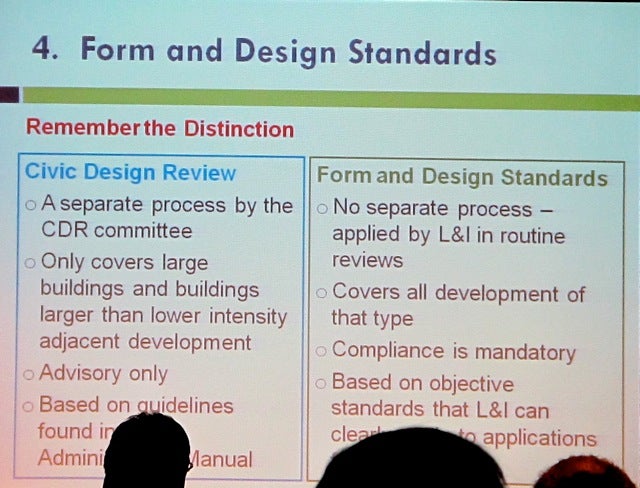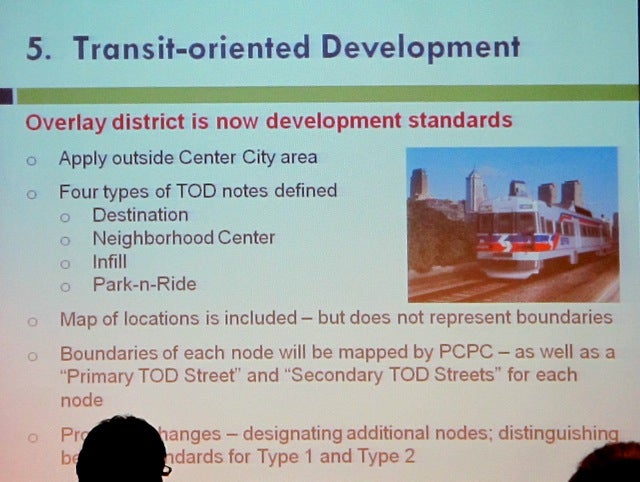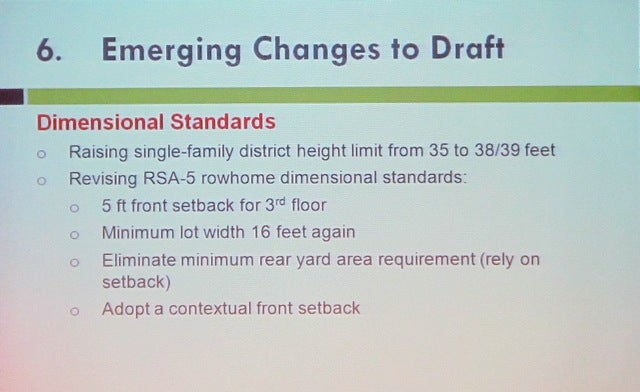ZCC keeps on drafting, wants more feedback
Well, perhaps less drafting, but more editing. As discussion of the draft revision of Philadelphia’s Zoning Code steams ahead, changes are afoot, and the Zoning Code Commission has extended the deadline for comment on the draft.
Alan Greenberger announced to the Zoning Code Commission Wednesday morning that Gary Jastrzab is returning to his previous position as executive director of the Philadelphia City Planning Commission. Jastrzab will represent PCPC on the ZCC, and Greenberger will stay on as chair of PCPC and will continue to help shepherd the zoning revision process.
With the full draft of the revised Zoning Code available and with the advent of numerous open houses to discuss it, the ZCC has piqued the attention of community groups, individuals, and developers alike. According to Greenberger, many stakeholders have requested extensions of the deadline for written comment on the draft of the revised Zoning Code. The new deadline is November 12.
“It’s a once-in-a-lifetime opportunity to fix something that hasn’t been attended to for a very long time,” Greenberger said.
Nonetheless, Don Elliott, the ZCC’s lead consultant, warned against what he called the “myth of delay,” and encouraged the commission to take the feedback given by the deadline, then address future concerns as they arise.
“It is not true that if we just held it off for another month we’ll catch them all,” Elliott said.
ZCC executive director Eva Gladstein informed the commission that outreach continues. According to Gladstein, the Urban Land Institute, following on last month’s panel, has offered to set up additional roundtable discussions. Gladstein also has plans to meet with the Committee of Seventy and ask for their endorsement of the code, and to continue meeting one-on-one with civic associations who request it. In addition, she said the scheduled December 8 meeting of the ZCC maybe be broken into two meetings, one December 1, the other December 15, in order to complete this phase of the commission’s work.
Civic Engagement Committee chair Stella Tsai said that one item raised in community meetings has been sign control, an issue she turned over to Gladstein. Thus far, according to Gladstein, the revised code has only reorganized the existing controls without any substantive changes, and any revisions to those controls will happen after the Zoning Code revision goes to City Council.
“There’s a lot of conflict, a lot of confusion. Different things are defined in different districts for no reason,” Gladstein said regarding the sign regulations.
Much of the meeting focused on the discussion of new items introduced in this draft and on the ongoing evolution of the code, particularly edits recommended by the Work Plan Committee. According to Peter Kelsen, that committee’s chair, feedback from three sources—members of the committee, members of the public, and an internal city review group that includes the Planning Commission, Licensing and Inspections, and others—is making its way in to the committee’s recommendations.
On Wednesday, Kelsen asked the ZCC to support the edits proposed by his committee, including raising the height limit for single-family homes from 35 to nearly 40 feet; requiring contextual setbacks of higher floors where a building abuts others on either side; and limiting to retail stores the requirement that 30 percent of street level facade be composed of transparent windows or doors.
Kelsen and Elliott also discussed at length the concept of sky plane, a notion new to this revision of the Zoning Code. Despite the city’s density and often small streets, They said that Philadelphians enjoy ample access not only to sunlight but to open sky. The sky plane regulation, which governs both the height and the bulk of buildings on Chestnut and Walnut Streets in Center City, is designed to preserve that openness.
A sky plane ratio will be created in the still-to-come Zoning Code Administrative Manual—a draft of which Gladstein said was circulating among city agencies—and that ratio will define an acceptable amount of sky to see when looking up at a building from street level. According to Elliott, regulating viewable sky instead of simply regulating height will create a positive upshot for architects, designers, developers, and, hopefully, the man on the street.
“It appears that this approach will not only allow more flexibility to architects and designers to build good buildings but will allow, probably, more square footage and a more profitable investment climate in Philadelphia. So if you can do both of those things—allow investors the opportunity to make money and better buildings—that’s why it’s worth the trouble of working through this now,” Elliott said.
The next full meeting of the ZCC is October 27 at 8:00 am. The ZCC will an open house for the 5th Council District on October 12, for the 7th Council District on October 13, for the 8th Council District on October 19, and for the 9th Council District on October 21. All four open houses take place at 6:00 p.m.
Contact the reporter at nick.gilewicz@gmail.com
WHYY is your source for fact-based, in-depth journalism and information. As a nonprofit organization, we rely on financial support from readers like you. Please give today.















